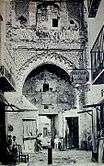Corral del Carbón



The Corral del Carbón or Correo de los Moros is a 14th-century monument located in the Spanish city of Granada (Andalusia). It is the only Nasrid alhóndiga preserved in its entirety in the Iberian peninsula.
History
It was built during the Nasrid reign before 1336, and his original name was Al-Funduq al-Gidida or New Alhóndiga. Located south of the Muslim city, next to the silk market or Alcaicería, to the souk of the Medina and to the Main Mosque, served as inn for merchants in transit, warehouse and wholesale market. A small bridge was called al-qantara al-yadída (new bridge) until 1501, and later puente del carbón or puente del Álamo or puente de los Curtidores (qantarat al-Dabbayin), located on the Darro River communicated the Alhóndiga with the souk. In general, as described Leopoldo Torres Balbás (Chronicles of Archaeology of Muslim Spain, XIX. Tomo 2. PP 235), this building responds to an Oriental model, but the decor and the details are distinctly Grenadian. Its ancestry can be traced from the Greek agoras, through the after the Roman horreum until Islamic times. The monumental cover comes from the eastern iwan, whose origins have been much discussed, and that is already in the Sassanian palaces. The transmission to the West would be through the Egypt, where the entrance portico opened by a large arch, vaulted with mocárabes, and at the bottom is the lintel door of access to the building, and a twin window above, is architectural layout very widespread. It is for example in Cairo in the Al-Zahir of Baybars I (665-1309) or Granada with the Gate of Justice in Alhambra (749-1348).
In 1494 the Catholic Monarchs granted to Sancho de Arana. At his death (1531) it came to auction, being used as hosting of chickadees, later as corral de comedias (until 1593) and then tenement house. It was declared a National Historic-Artistic Monument in 1918, but was threatened with demolition until it was acquired by the state in 1933, which commissioned its restoration to Leopoldo Torres Balbás. In 1992 was again restored by the architect Rafael Soler Márquez, although remained some flaws that were not corrected until another restoration. The facade was operated with treatments of cleaning and consolidation by the company Siglos Conservación y Restauración, s.l., under the direction of the restorers Lola Blanca López and Lourdes Blanca López. Intervention completed in November 2006.
Description
The facade, richly decorated with plaster, is dominated by a large tumid arc (two centers and some shored) provided with alfiz. On its horizontal molding there a Kufic epigraphic decoration. A shaft on it, stands a geminare vain. It is topped by a large overhanging eaves supported by wooden corbels in the Nasrid tradition (Golden Room of the Alhambra).
After the hall, covered with a vault of mocárabes that retains some other polychromatic, it enter to the courtyard. This, of quadrangular plant, is functional without decorative excesses. In its center is a stone basin provided with two pipe stands.
The structure of the three floors provided of galleries that open to the courtyard is formed by stone pillars and beams and footings (the latter carved) of wood. Dickies factory is brick. The interior of the halls is very transformed to house shops and offices.
Current use
It currently houses the offices and personnel administration of City of Granada Orchestra, and is home to the International Festival of Music and Dance of Granada. It is also occasional stage in the courtyard, of theatrical performances, flamenco concerts and conferences.
Gallery
 Status of the Corral del Carbón in the year 1900, seen from a narrow street.
Status of the Corral del Carbón in the year 1900, seen from a narrow street.
External links
| Wikimedia Commons has media related to Corral del Carbon. |
Bibliography
- Granada in your hands. Historic center (I). Author: José Manuel Gómez-Moreno Calera and others. Ideal - 2006.
- Bustos Rodríguez, Juan. Journey to the Center of Granada. Granada, Albaida, 1996.
Coordinates: 37°10′30″N 3°35′53″W / 37.1749°N 3.5980°W